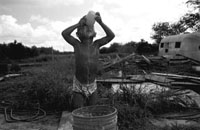|
June 12 , 2000 Poverty in America: Turning
the Tables Allied
Forces Poverty
in a Gilded Age Out
of Sight Leave
the Kids Alone The
Union Difference Down
and Out on Polk Street Other Features: Star
Wars: Episode Two "This
Is Not Life. This Is Prison" Bosnian
Serbs Still Look to Belgrade Editorial Appall-O-Meter Marching
On The
Other Side of the Street Going
to Waste Profile
Forgotten
America Ancient
Daze A
Class by Itself A
Different Point of View |
Leave the Kids
Alone
Poverty is their real problem
By Mike Males
In a boom economy, the most recent figures show that a staggering 40 percent of America's children and youth remain in low-income families. Thirteen million are poor, and 6 million of those suffer destitution in households with less than half of poverty-level income. U.S. child poverty rates are two to 10 times higher than in Western Europe, Canada or Australia. Poverty is so strongly connected to nearly everything adults think is wrong with "kids today"--murder, violent crime, unintended pregnancy, AIDS, smoking, dropping out of school--that it dwarfs every other factor.
 |
|
Arturo
Coronado bathes at his family home in Alamo, Texas. Credit: Impact
Visuals
|
Yet child poverty is rarely discussed today, buried under the popular,
all-consuming "values" crusade and by the usefulness of children in pushing
other agendas. New Democrats and Republicans agree that today's big menaces
to kids are violent video games, TV, caffeine, R-rated movies, unfiltered
Internet porn, raves, gangstas, Marilyn Manson, baggy pants, or any unmonitored
free time. White kids with guns grace "kids without a conscience" cover
stories in People and Rolling Stone that dismiss poverty
as irrelevant.
But in the real world, the likelihood of a youth being killed by gunfire,
getting arrested, going to prison or dying before age 25 has a lot more
to do with how poor he or she is. Obsession with fictional screen images
crowds out realities of grinding poverty, crumbling schools, vanished
jobs and grownups in disarray. Culture warriors such as President Clinton,
former Education Secretary Bill Bennett, the Manhattan Institute's Kay
Hymowitz, Tribe Apart author Patricia Hersch and West Point video-game
blamer Dave Grossman cite (or more often distort) scary statistics to
buttress claims of a "youth culture" driven by pop-culture corruption
into mass degeneration.
In truth, where U.S. kids enjoy low poverty rates like those of Europe,
there are correspondingly low murder and gun-fatality rates. In California's
five richest urban counties, with a combined population of 6 million,
white teen-agers' poverty rates average 4 percent-similar to those of
Scandinavian youth. Even in this state with one of America's highest gun-fatality
rates-where white households are the most likely to harbor guns, violent
cable channels and video games-the gun death rate among white teens (three
per 100,000) is as low as Sweden's or Canada's. Meanwhile, poorer California
youth of all colors (the vast majority black, Latino and Asian) suffer
gun-fatality rates three to eight times higher. Poverty is associated
with 85 percent of gun deaths among children and youths, as well as the
adults who commit most murders of children. The figures on gun murders
per 100,000 youths show that class, not race, is the issue: richer white
(0.8), middle-income white (2.1), lower-income color (3.1), poorer color
(6.7). (Poorer California white youth are more affluent than the average
youth of color.)
![]()
|
In These Times ©
2000
Vol. 24, No. 14 |
